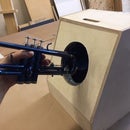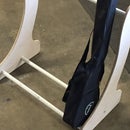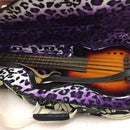Introduction: A Simple Tool Roll
If you are like me, you end up with a lot of little hand tools cluttering up the gig bag. And if you have access to a sewing machine, a few hours of work can save a remarkable amount of hassle later on. I did this thing to learn more about my new Bernina, but it has paid for itself many times over in the sheer convenience of keeping everything I need sorted and easy to transport to the theater.
Step 1: Measure
Since you are making your own Tool Roll, then go ahead and customize to the tools you want to have in it. No reason to be stuck with random pockets.
This is as simple as laying all the tools you want on a piece of butcher paper, with enough space between them so they'll roll. Give yourself some spare pockets, though. You'll always end up adding something later.
Step 2: Cut and Hem
The fabric I chose was a lovely upholstery fabric that looked like an old carpet bag. Remnants are the way to go here; you don't need much fabric for a Tool Roll, it saves money, and poking through the remnants bin at your favorite fabric store will pull up things you didn't think you were looking for. Always embrace discovery.
This particular fabric is a coarse weave that frays easily. So it is backed with a tighter weave duck, which is the fabric used for the pockets.
Cut out your paper plan. Trace around it, and cut your fabric. Pin the shell and liner together, hem them, then zig-zag the edge (I assume you don't have a serger either).
Step 3: Flaps
The piece that will make the pocket needs to be cut long. This is a judgement call, but if you have the fabric it can't hurt to have extra. I cut mine at 150% the length of the roll.
The top edge is zig-zagged, turned over, pressed and hemmed, then a second line of stitching put in 1/8" from the edge to keep the hem lying flat. Depending on the fabric, you may wish to turn yours twice and enclose the raw edge of the fabric completely.
Start from one edge, stitching it into the shell, then go one tool or pocket at a time; holding the fabric up to form the space for the pocket, then stitching it down. The key here is all the give is on your inner layer; that means the shell remains (more or less) smooth.
Now, the place I messed up on this one was not running a gather stitch. Simplest way to do this is lay a piece of heavy thread down, then do a loose zig-zag over it. You can then push the fabric along that thread to get a neater gather.
Or if you are lazy like me, just stuff the excess in and stitch it down.
Step 4: Detailing
Don't forget to add some extra slots.
Another very useful thing to add are proper pockets. Stitch velcro patches in before forming these! These will come in handy down the road for holding random bits of hardware and electronics, test cables, tape, etc.
For mine, I wanted to be able to use the Multimeter without taking it out of the roll. This is how you do that; start with a piece of flexible plastic. I cut mine out of a shower bag I salvaged from the thrift store. Use grease pencil or sharpie to make out the button holes, then cut them out with a craft knife. It may take several tries to get them right.
Cut an "X" across the hole, fold back and press the flaps created. Trim them to size and hem around the edge. Now you can stitch the plastic insert into the space.
And, yes, you do this before you start sewing the flap into place!
Step 5: Buckle
You will be opening this thing a lot. Find fasteners that take minimal effort to operate. I chose the snap buckle you see, which unfortunately was the only one left in the store (why I have only one strap instead of two).
Alternatives are velcro, snaps, or the shoelace tie of the true traditionalist.
Go slow and use a sharp needle on webbing, of course. But other than that, it is just throwing a few good rows of stitches in, and pulling it through the hardware of your choice. (For a really traditional look, recycle an old belt or spend some time distressing raw leather strips from Tandy -- see my other Instructable.)
Oh, right. And there's the edge treatment, which I didn't get any pictures of.
Practically anything will do to finish the edge. Double-turned seams (if you use curved edges like I did, these can be quite a hassle of clipping and folding, though). Bias tape, or self-bias with one of the fabrics you've used, or a contrasting fabric.
Or decorative edging like this; I found some faux leather stuff that stretched easily and was fairly simple to bend around the turns. I held it in place largely with small binder clips (you can't really pin it), but it is a bit of a pain to get it lined up properly so that your stitch falls that clean 1/8" from the edge on both inside and outside. In a number of places, I failed, and I even ripped out a few feet, but at first glance it doesn't look too bad.
And it protects the edge from fraying, and looks cool while doing it, which is what it is for. What, really, about half of what you will ever do with fabric is for.





